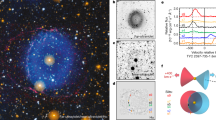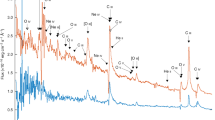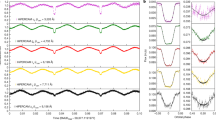Abstract
CK Vulpeculae was observed in outburst in 1670–1672 (ref. 1), but no counterpart was seen until 1982, when a bipolar nebula was found at its location1,2,3. Historically, CK Vul has been considered to be a nova (Nova Vul 1670), but its similarity to ‘red transients’, which are more luminous than classical novae and thought to be the results of stellar collisions4, has re-opened the question of CK Vul’s status5,6. Red transients cool to resemble late M-type stars, surrounded by circumstellar material rich in molecules and dust7,8,9. No stellar source has been seen in CK Vul, though a radio continuum source was identified at the expansion centre of the nebula3. Here we report that CK Vul is surrounded by chemically rich molecular gas in the form of an outflow, as well as dust. The gas has peculiar isotopic ratios, revealing that CK Vul's composition was strongly enhanced by the nuclear ashes of hydrogen burning. The chemical composition cannot be reconciled with a nova or indeed any other known explosion. In addition, the mass of the surrounding gas is too large for a nova, though the conversion from observations of CO to a total mass is uncertain. We conclude that CK Vul is best explained as the remnant of a merger of two stars.
This is a preview of subscription content, access via your institution
Access options
Subscribe to this journal
Receive 51 print issues and online access
$199.00 per year
only $3.90 per issue
Buy this article
- Purchase on Springer Link
- Instant access to full article PDF
Prices may be subject to local taxes which are calculated during checkout


Similar content being viewed by others
References
Shara, M. M., Moffat, A. F. J. & Webbink, R. F. Unraveling the oldest and faintest recovered nova—CK Vulpeculae (1670). Astrophys. J. 294, 271–285 (1985)
Shara, M. M. & Moffat, A. F. J. The recovery of CK Vulpeculae Nova 1670—the oldest ‘old nova'. Astrophys. J. 258, L41–L44 (1982)
Hajduk, M. et al. The enigma of the oldest ‘nova’: the central star and nebula of CK Vul. Mon. Not. R. Astron. Soc. 378, 1298–1308 (2007)
Tylenda, R. et al. V1309 Scorpii: merger of a contact binary. Astron. Astrophys. 528, A114 (2011)
Kato, T. CK Vul as a candidate eruptive stellar merging event. Astron. Astrophys. 399, 695–697 (2003)
Tylenda, R. et al. OGLE-2002-BLG-360: from a gravitational microlensing candidate to an overlooked red transient. Astron. Astrophys. 555, A16 (2013)
Kamiński, T., Schmidt, M., Tylenda, R., Konacki, M. & Gromadzki, M. Keck/HIRES spectroscopy of V838 Monocerotis in October 2005. Astrophys. J. Suppl. Ser. 182, 33–50 (2009)
Kamiński, T., Schmidt, M. & Tylenda, R. V4332 Sagittarii: a circumstellar disc obscuring the main object. Astron. Astrophys. 522, A75 (2010)
Nicholls, C. P. et al. The dusty aftermath of the V1309 Sco binary merger. Mon. Not. R. Astron. Soc. 431, L33–L37 (2013)
Ziurys, L. M., Tenenbaum, E. D., Pulliam, R. L., Woolf, N. J. & Milam, S. N. Carbon chemistry in the envelope of VY Canis Majoris: implications for oxygen-rich evolved stars. Astrophys. J. 695, 1604–1613 (2009)
Quintana-Lacaci, G. et al. Detection of circumstellar nitric oxide. Enhanced nitrogen abundance in IRC +10420. Astron. Astrophys. 560, L2 (2013)
Loinard, L., Menten, K. M., Güsten, R., Zapata, L. A. & Rodríguez, L. F. Molecules in η Carinae. Astrophys. J. 749, L4 (2012)
Romano, D. & Matteucci, F. Nova nucleosynthesis and Galactic evolution of the CNO isotopes. Mon. Not. R. Astron. Soc. 342, 185–198 (2003)
Kamiński, T. Extended CO emission in the field of the light echo of V838 Monocerotis. Astron. Astrophys. 482, 803–808 (2008)
Mamon, G. A., Glassgold, A. E. & Omont, A. Photochemistry and molecular ions in oxygen-rich circumstellar envelopes. Astrophys. J. 323, 306–315 (1987)
Hajduk, M., van Hoof, P. A. M. & Zijlstra, A. A. CK Vul: evolving nebula and three curious background stars. Mon. Not. R. Astron. Soc. 432, 167–175 (2013)
Bujarrabal, V., Alcolea, J., Sánchez Contreras, C. & Sahai, R. HST observations of the protoplanetary nebula OH 231.8+4.2: the structure of the jets and shocks. Astron. Astrophys. 389, 271–285 (2002)
Soker, N. & Kashi, A. Formation of bipolar planetary nebulae by intermediate-luminosity optical transients. Astrophys. J. 746, 100 (2012)
Szyszka, C., Zijlstra, A. A. & Walsh, J. R. The expansion proper motions of the planetary nebula NGC 6302 from Hubble Space Telescope imaging. Mon. Not. R. Astron. Soc. 416, 715–726 (2011)
Prieto, J. L., Sellgren, K., Thompson, T. A. & Kochanek, C. S. A. Spitzer/IRS spectrum of the 2008 luminous transient in NGC 300: connection to proto-planetary nebulae. Astrophys. J. 705, 1425–1432 (2009)
Lodders, K. Solar system abundances and condensation temperatures of the elements. Astrophys. J. 591, 1220–1247 (2003)
Kobayashi, C., Karakas, A. I. & Umeda, H. The evolution of isotope ratios in the Milky Way Galaxy. Mon. Not. R. Astron. Soc. 414, 3231–3250 (2011)
Denissenkov, P. A. et al. MESA and NuGrid simulations of classical novae: CO and ONe nova nucleosynthesis. Mon. Not. R. Astron. Soc. 442, 2058–2074 (2014)
Arnould, M., Goriely, S. & Jorissen, A. Non-explosive hydrogen and helium burnings: abundance predictions from the NACRE reaction rate compilation. Astron. Astrophys. 347, 572 (1999)
Amari, S. et al. Presolar grains from novae. Astrophys. J. 551, 1065–1072 (2001)
Nittler, L. R. & Hoppe, P. Are presolar silicon carbide grains from novae actually from supernovae? Astrophys. J. 631, L89–L92 (2005)
José, J. & Hernanz, M. The origin of presolar nova grains. Meteorit. Planet. Sci. 42, 1135–1143 (2007)
Güsten, R. et al. The Atacama Pathfinder EXperiment (APEX)—a new submillimeter facility for southern skies. Astron. Astrophys. 454, L13–L16 (2006)
Vassilev, V. et al. A Swedish heterodyne facility instrument for the APEX telescope. Astron. Astrophys. 490, 1157–1163 (2008)
Klein, T. et al. FLASH+—a dual-channel wide-band spectrometer for APEX. IEEE Trans. Terahertz Sci. Technol. 4, 588–596 (2014)
Kasemann, C. et al. CHAMP+: a powerful array receiver for APEX. SPIE Conf. Ser. 6275, 62750N (2006)
Klein, B. et al. High-resolution wide-band fast Fourier transform spectrometers. Astron. Astrophys. 542, L3 (2012)
Sault, R. J., Teuben, P. J. & Wright, M. C. H. A retrospective view of MIRIAD. Astron. Data Analysis Software Syst. IV 77, 433 (1995)
Pickett, H. M. et al. Submillimeter, millimeter and microwave spectral line catalog. J. Quant. Spectrosc. Radiat. Transf. 60, 883–890 (1998)
Müller, H. S. P., Schlöder, F., Stutzki, J. & Winnewisser, G. The Cologne Database for Molecular Spectroscopy, CDMS: a useful tool for astronomers and spectroscopists. J. Mol. Struct. 742, 215–227 (2005)
Müller, H. S. P. et al. The Cologne Database for Molecular Spectroscopy, CDMS: a tool for astrochemists and astrophysicists. IAU Symp. 235, 62P (2005)
Goldsmith, P. F. & Langer, W. D. Population diagram analysis of molecular line emission. Astrophys. J. 517, 209–225 (1999)
Vastel, C. Formalism for the CASSIS Softwarehttp://cassis.irap.omp.eu/docs/RadiativeTransfer.pdf (2014)
Weight, A., Evans, A., Albinson, J. S. & Krautter, J. Millimetre observations of old novae. Astron. Astrophys. 268, 294–298 (1993)
Williams, G. CBAT List of Novae in the Milky Wayhttp://www.cbat.eps.harvard.edu/nova_list.html (2014)
Tielens, A. G. G. M. & Allamandola, L. J. Composition, structure, and chemistry of interstellar dust. Interstellar Processes 134, 397–470 (1987)
Beckwith, S. V. W. & Sargent, A. I. Particle emissivity in circumstellar disks. Astrophys. J. 381, 250–258 (1991)
Draine, B. T. On the submillimeter opacity of protoplanetary disks. Astrophys. J. 636, 1114–1120 (2006)
Molinari, S. et al. Hi-GAL: The Herschel Infrared Galactic Plane Survey. Publ. Astron. Soc. Pacif. 122, http://dx.doi.org/10.1086/651314 (2010)
Wright, E. L. et al. The Wide-field Infrared Survey Explorer (WISE): mission description and initial on-orbit performance. Astron. J. 140, 1868–1881 (2010)
Yamauchi, C. et al. AKARI-CAS—online service for AKARI all-sky catalogues. Publ. Astron. Soc. Pacif. 123, 852–864 (2011)
Evans, A. et al. CK Vul: reborn perhaps, but not hibernating. Mon. Not. R. Astron. Soc. 332, L35–L38 (2002)
Bode, M. F., Seaquist, E. R. & Evans, A. Radio survey of classical novae. Mon. Not. R. Astron. Soc. 228, 217–227 (1987)
Hajduk, M. et al. On the evolved nature of CK Vul. ASP Conf. Ser. 391, 151 (2008)
Acknowledgements
We thank F. Wyrowski, A. Belloche, T. Csengeri, K. Immer, K. Young and the APEX staff for executing part of the observations reported here. APEX is a collaboration between the Max-Planck-Institut für Radioastronomie, the European Southern Observatory, and Onsala Space Observatory. The SMA is a joint project between the Smithsonian Astrophysical Observatory and the Academia Sinica Institute of Astronomy and Astrophysics. We thank the SMA director R. Blundell for granting us director’s discretionary time. The Effelsberg 100-m radio telescope is operated by the Max-Planck-Institut für Radioastronomie on behalf of the Max-Planck-Gesellschaft.
Author information
Authors and Affiliations
Contributions
T.K. wrote the text. T.K. and K.M.M. obtained and reduced the APEX data. N.A.P. obtained and reduced the SMA data. A.K. obtained and reduced the Effelsberg data. All authors contributed to the interpretation of the data and commented on the final manuscript.
Corresponding author
Ethics declarations
Competing interests
The authors declare no competing financial interests.
Extended data figures and tables
Extended Data Figure 1 Spectral energy distribution of CK Vul.
Flux measurements and 3σ upper limits were collected from the literature and include data points obtained with the SMA in this study — as listed in Extended Data Table 4. Best-fit Planck function and modified grey-body spectral distributions are also shown. See Methods for details.
PowerPoint slides
Rights and permissions
About this article
Cite this article
Kamiński, T., Menten, K., Tylenda, R. et al. Nuclear ashes and outflow in the eruptive star Nova Vul 1670. Nature 520, 322–324 (2015). https://doi.org/10.1038/nature14257
Received:
Accepted:
Published:
Issue Date:
DOI: https://doi.org/10.1038/nature14257
This article is cited by
Comments
By submitting a comment you agree to abide by our Terms and Community Guidelines. If you find something abusive or that does not comply with our terms or guidelines please flag it as inappropriate.



